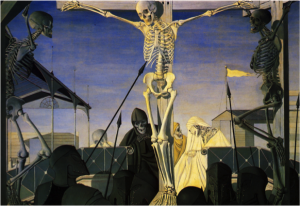Paul Delvaux, ‘Crucifixion’ – oil on wood- 1952
In the 1950s Delvaux painted a series that revised an old subject that was prolific during the Medieval and Renaissance eras, the Passion of Christ. He did, however, not want to recite the same imagery as paintings from earlier periods. He decided to paint all the figures as skeletons, in nearly all of the paintings. He uses the skeletons to represent the fragility of life, and employs them as a tool to shock the viewer into being reminded of life and its fleeting absence. In this way we could easily look at the painting as a Vanitas. This specific painting from the series shows three crucified figures above a number of fully armoured centurions. The middle figure is illuminated, strongly suggesting that this is Christ, could this represent significance is still present after death? Or is it simply for aesthetic reasons? This painting raises many questions, and takes time to properly understand. Usually depictions of the crucifixion of Christ are in a countryside landscape, as Christ was crucified on top of a hill, whereas here we see a strong contrast to this as it is set in a built up area. The strange architectural shapes create strong hard lines throughout the image, and give the painting a more ‘modern’ film. This could be Delvaux trying to transport the theme of the ‘Passion of Christ’ into a more contemporary era, carrying the message to the viewer that these old Vanitas values still apply.

